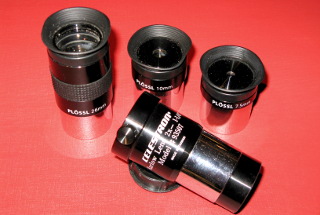
- 40 mm, 26 mm, 10 mm, 7.5 mm focal lengths
- No-name, yet high quality, eyepieces from Teknofokus
- These are truly excellent eyepieces and have served me a long time with my 200 mm telescope
- Celestron achromatic Barlow lens—for those select evenings when the atmosphere seems to have disappeared. Saturn at 350×, yum! (Yes, even in a 200 mm scope. Maybe it doesn't resolve more detail for an optically perfect eye, but bigger is better for pretty much everyone else!)
- But once you've looked through a Nagler, Plössls just seem so... narrow. (Here's hoping I never get to look through an Ethos!)
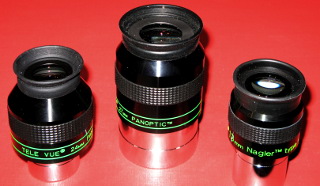
- 27 mm, 24 mm Panoptic
- 13 mm Nagler Type-VI
The 27 mm Pan is maybe a bit too wide, showing just too much coma in an f/4.5 Newtonian scope. The 24 mm shows less coma, and it comes in a 1 1/4" barrel (the 26 has a 2" barrel), and therefore fits better in my filter adapters.
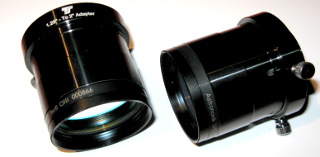
- Astronomik 2" O-III visual filter
- Astronomik 2" UHC visual filter
- Both in their own 1 1/4" to 2" adapters

- Lumicon 1 1/4" O-III—my old deep-sky filter. After 10+ years of use, it has developed a spotted appearance—that can't be good.
- Baader 1 1/4" Neodymium filter—Very good for improving contrast on Jupiter and Saturn! (Also great fun for eyeballing daytime surroundings; some shades of red are strikingly emphasized! Guess why neodymium lamps are so popular in the supermarket vegetable section, especially subsection tomatoes? Also "plant lights" for home use utilize the same spectral response.)
- 1 1/4" Neutral density lunar filter, 2% transmission. (An acquaintance of mine stubbornly claims you don't need a lunar filter in a 200 mm scope. Regrettably, I've never had the pleasure of showing him the full Moon through my scope unfiltered...)
- 1 1/4" #21 orange filter, which I bought once when Mars was in opposition. Not that effective, really.
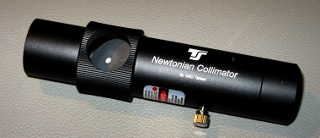
- Really the easiest way to collimate a newtonian
- Funny, inside this contraption there is a laser pointer! Those things must be cheaper than the laser diodes they contain!
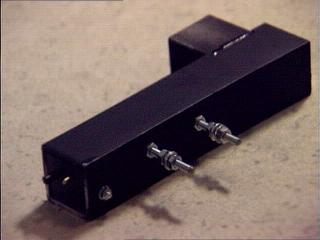
- Ever since I built myself a Telrad-clone, I've never wished for a finder scope, although I once had a very good one (home-made also) on my 200 mm scope (before rebuilding it from aluminum)
- The optics comprise a microscope slide, a lens, a first-surface mirror, and the bullseye pattern photographed onto black-and-white negative film, illuminated from behind with an adjustable red LED
- I rarely make use of the bullseye ring pattern, so a red-dot sight would do almost as well
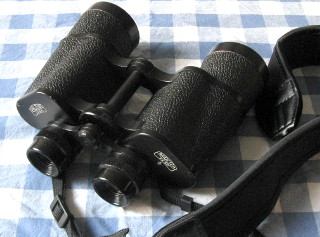
I have gone through several pairs of cheap binoculars, some bought second-hand, some bought new, some quite decent for their price, some optically beautiful but utter plastic rubbish mechanically. Some I have purposefully destroyed to obtain optical parts, some have broken down because... because they are utter plastic rubbish mechanically. The optics are glass, of course. And, surprisingly, even the cheapest plastic rubbish 7×50 binos that I've used have been optically quite decent! I guess it's not rocket science to make an optically decent pair of 7×50s, but I can't say the same for most 10×50s I've tried. Strange.
Finally I paid up and got myself a pair of vintage Carl Zeiss Jena Binoctem 7×50 binoculars, made in East Germany. Based on the serial number, they were produced in 1983 and they do obviously have multi coated optics. Yea, legendary Carl Zeiss glass from Jena, DDR. Mint condition, complete with ugly faux leather case. I swapped the original masochist neck strap for a padded one, and I love these. Just watch out for fakes when bidding on eBay, and buy from a reputable seller.
Since then, I have also obtained a nice pair of mint condition ЗОМЗ БПЦ (ZOMZ Zagorsk "BPC") 7×50 binoculars, made in the USSR (i.e. way before Mr. P's regime). The optics are tack-sharp, but the focusing mechanism is waiting to have its authentic Soviet all-purpose grease cleaned out and replaced with something that actually enables the parts to move. (I have a tube of Synco Chemical Corporation Super Lube in my chemicals shelf for that purpose. Many astro forums rated that stuff above generic lithium grease, especially for use at below-freezing temperatures. The manufacturer specifies it down to −40°C.)